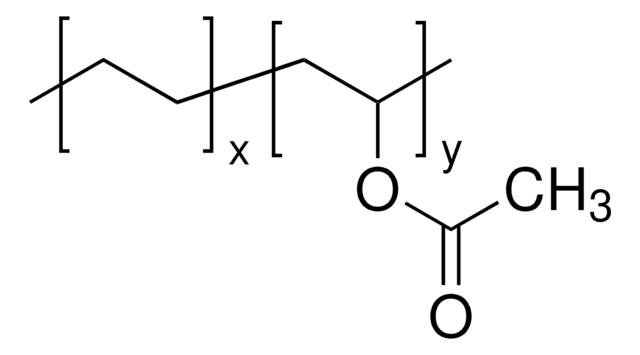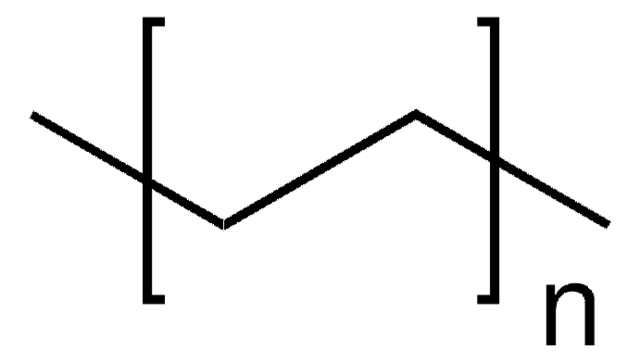340502
Poly(ethylene-co-vinyl acetate)
vinyl acetate 40 wt. %, melt index (41-63 dg/min (190°C/2.16kg)), contains 190-910 ppm inhibitor
Synonym(s):
PEVA
About This Item
Recommended Products
form
beads
autoignition temp.
500 °F
melt index
(41-63 dg/min (190°C/2.16kg))
contains
190-910 ppm inhibitor
composition
vinyl acetate, 40 wt. %
hardness
40 (Shore A-2, ASTM D 2240)
transition temp
Tg −40-−30 °C
Tm 110-120 °C
solubility
toluene, THF, and MEK: soluble
SMILES string
C=C.CC(=O)OC=C
InChI
1S/C4H6O2.C2H4/c1-2-3-4(5)6;1-2/h2H,1,3H2,(H,5,6);1-2H2
InChI key
DQXBYHZEEUGOBF-UHFFFAOYSA-N
Looking for similar products? Visit Product Comparison Guide
Related Categories
General description
Application
- Correlation between Cohesive Energy Density, Fractional Free Volume, and Gas Transport Properties: This study explores the properties of EVA materials that affect their gas permeability, important for applications like packaging and barrier materials (Kubica & Wolinska-Grabczyk, 2015).
- The Thermal and Mechanical Properties of EVA and its Crosslinked Analogues: This research investigates how crosslinking affects the thermal and mechanical properties of EVA, which could interest material scientists working with polymers (Wang & Deng, 2019).
- Investigation of morphological, rheological, and mechanical properties of cyclic olefin copolymer/EVA blend films: This study focuses on the blend properties of EVA with other polymers, providing insights useful in academia and material science (Durmus et al., 2018).
- Fabrication, characterization, and properties of EVA/magnetite nanocomposites: Relevant to material scientists, this research discusses the incorporation of magnetite nanoparticles into EVA for enhanced properties (Ramesan, 2014).
Storage Class Code
11 - Combustible Solids
WGK
nwg
Flash Point(F)
Not applicable
Flash Point(C)
Not applicable
Personal Protective Equipment
Choose from one of the most recent versions:
Already Own This Product?
Find documentation for the products that you have recently purchased in the Document Library.
Articles
In this article, we discuss issues critical to successful application of the electrospinning technique, including control of individual nanofibers to form secondary structures and assembly of nanofibers into 3D architectures.
Our team of scientists has experience in all areas of research including Life Science, Material Science, Chemical Synthesis, Chromatography, Analytical and many others.
Contact Technical Service







